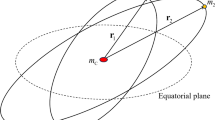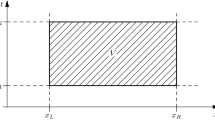Abstract
An implementation of a fourth-order symplectic algorithm to the logarithmic Hamiltonian of the Newtonian circular restricted three-body problem in an inertial frame is detailed. The logarithmic Hamiltonian algorithm produces highly accurate results, comparable to the non-logarithmic one. Its numerical performance is independent of an orbital eccentricity. However, it is not when some post-Newtonian terms are included in this problem. Although the numerical accuracy becomes somewhat poorer as the orbital eccentricity gets larger, it is still much higher than that of the non-logarithmic Hamiltonian algorithm. As a result, the present code can drastically eliminate the overestimation of Lyapunov exponents and the spurious rapid growth of fast Lyapunov indicators for high-eccentricity orbits in the Newtonian or post-Newtonian circular restricted three-body problem.









Similar content being viewed by others
Notes
If \(T\) is still positive definite while \(U\) does not explicitly depend on time \(t\) and is not negative definite, we have no choice but use \(T\equiv-p_{0}-U\) as two distinct, equivalent forms of the time-step function \(g\).
The other initial conditions and all the parameters are the same above-mentioned ones.
We should require \(t\rightarrow(1+\omega_{1})t\) in Eq. (19).
The numerically integrated orbits in the PN case are the same as those in the Newtonian case. That is to say, the initial values of \(\dot{y}\) are still given by Eq. (18). In this sense, the values of the Jacobian constants \(C_{J}\) and \(C^{PN}_{J}\) are somewhat different.
This order is much larger than the initial distance \(d(0)=10^{-8}\).
In this case, new time step \(d s=h\) corresponds to the physical time interval \(d t=h/K_{n-1}\). This shows clearly that the new time step \(h\) is fixed but the physical time steps are frequently readjusted at various physical times \(t_{n-1}\) (\(n=1,2,3,\cdots\)).
The factor \(1/c^{2}\) (or \(1/a\)) denotes 1PN contributions and \(1/c^{4}\) (or \(1/a^{2}\)) corresponds to 2PN contributions.
References
Chandrasekhar, S., Contopoulos, G.: Proc. R. Soc. A 298, 123 (1967)
Emel’yanenko, V.V.: Celest. Mech. Dyn. Astron. 98, 191 (2007)
Forest, E., Ruth, R.D.: Physica D 43, 105 (1990)
Froeschlé, C., Lega, E.: Celest. Mech. Dyn. Astron. 78, 167 (2000)
Huang, G., Wu, X.: Phys. Rev. D 89, 124034 (2014a)
Huang, G., Wu, X.: Gen. Relativ. Gravit. 46, 1798 (2014b)
Maindl, T.I., Dvorak, R.: Astron. Astrophys. 290, 335 (1994)
Mei, L., Ju, M., Wu, X., Liu, S.: Mon. Not. R. Astron. Soc. 435, 2246 (2013a)
Mei, L., Wu, X., Liu, F.: Eur. Phys. J. C 73, 2413 (2013b)
Mikkola, S.: Celest. Mech. Dyn. Astron. 67, 145 (1997)
Mikkola, S., Aarseth, S.: Celest. Mech. Dyn. Astron. 84, 343 (2002)
Mikkola, S., Tanikawa, K.: Celest. Mech. Dyn. Astron. 74, 287 (1999)
Mikkola, S., Tanikawa, K.: New Astron. 20, 38 (2013)
Ni, S., Wu, X.: Res. Astron. Astrophys. 14, 1329 (2014)
Preto, M., Tremaine, S.: Astron. J. 118, 2532 (1999)
Szebehely, V.: Theory of Orbits: The Restricted Problem of Three Bodies. Academic Press, New York (1967)
Wang, H., Huang, G.Q.: Commun. Theor. Phys. 64, 159 (2015)
Wu, X., Huang, T.Y.: Phys. Lett. A 313, 77 (2003)
Wu, X., Huang, G.: Mon. Not. R. Astron. Soc. 452, 3167 (2015)
Wu, X., Huang, T.Y., Zhang, H.: Phys. Rev. D 74, 083001 (2006)
Wu, X., Mei, L., Huang, G., Liu, S.: Phys. Rev. D 91, 024042 (2015)
Yoshida, H.: Phys. Lett. A 150, 262 (1990)
Zhong, S.Y., Wu, X., Liu, S.Q., Deng, X.F.: Phys. Rev. D 82, 124040 (2010)
Acknowledgements
The authors are grateful to two referees for valuable suggestions. This research is supported by the Natural Science Foundation of Jiangxi Province and the National Natural Science Foundation of China under Grant Nos. 11173012, 11178002 and 11533004.
Author information
Authors and Affiliations
Corresponding author
Appendices
Appendix A: Construction of logarithmic Hamiltonian algorithms in the rotating frame
In terms of extended phase space variables \((x,y,q_{0}; p_{x}, p_{y}, p_{0})\), the Hamiltonian (16) is rewritten as
where \(K=(p_{x}^{2}+p_{y}^{2})/2+p_{0}+yp_{x}-xp_{y}\) is the kinetic energy. We have the logarithmic Hamiltonian
The potential part \((-\log U)\) is only dependent on coordinates \(x\) and \(y\), so it is easily analytically solved. As to the kinetic part \(\log K\), it corresponds to canonical equations
If \(K\) is viewed as a constant at the \((n-1)\)th step of new time interval \([s_{n-1},s_{n}]\) and is labeled as \(K_{n-1}=K(x_{n-1},y_{n-1},p_{x,n-1},p_{y,n-1},p_{0}) \),Footnote 7 then Eq. (A.3) turns out to be the sum of the linear motion and rotation and is easily solvable. Therefore, the leapfrog Algorithm (11) is also valid to solve the logarithmic Hamiltonian \(\digamma\). We call it \(S^{*}_{2}\), which has the discrete difference formulae:
As a point to emphasize, \(U(x_{n-1},y_{n-1})\) is used instead of \(U(x^{*}_{n},y^{*}_{n})\) because of the theoretical result \(K_{n-1}\equiv U(x_{n-1},y_{n-1})\). Additionally, the difference between the present numerical approach (A.4) and Eq. (12) lies in that these variables \((x,y,p_{x},p_{y},p_{0})\) in \(K\) of Eq. (A.4) are taken as constants at time \(s_{n-1}\) but are not in \(T\) of Eq. (12). Replacing \(S_{2}\) in Eq. (13) with \(S^{*}_{2}\), we have a fourth-order integrator \(S^{*}\).
If \(K\) cannot be regarded as a constant at the \((n-1)\)th step, then Eq. (A.3) has no analytical solution. In this case, the second-order implicit midpoint method is suggested to numerically solve Eq. (A.3). When the leapfrog method (11) is still used, \(A\) is an implicit operator acting on \(\log K\) and \(B\) is an explicit operator acting on \((-\log U)\). Here the discrete difference formulae read
\(K^{*}\) and \(K^{\star}\) are
In fact this scheme, marked as \(S^{+}_{2}\), belongs to a second-order mixed symplectic integrator of explicit and implicit operators (Zhong et al. 2010). If the operators \(A\) and \(B\) in Eq. (11) are exchanged, more CPU times would be saved. In most cases, this kind of mixed symplectic integrator has less cost than the implicit midpoint method applied to the whole system. Of course, it is inferior to the explicit method (12) in the computational efficiency. However, it has a wider application; for example, it is suitable for solving PN Hamiltonian formulations (Mei et al. 2013a, 2013b). Using \(S^{+}_{2}\) instead of \(S_{2}\) in Eq. (13), we obtain another fourth-order symplectic integrator \(S^{+}\).
Appendix B: PN Lagrangian of relativistic restricted three-body problem
All the scaled variables \((t,x,y,\dot{x},\dot{y})\) in Eq. (14) or Eq. (17) are still used. Based on the first order post-Newtonian (1PN) gravitational equations of Einstein, Infeld, and Hoffmann in the inertial frame, the Lagrangian of the third body of the relativistic restricted three-body problem in the rotating frame is expressed as
In the above equation, \(\tilde{L}\) is given after the scale transformation \(\tilde{L}\rightarrow\tilde{L}/a\), the velocity of light \(c\) is only used to mark the order of PN contributions,Footnote 8 and \(c=1\) is taken in practical numerical computations. The 1PN angular speed is \(\omega_{1}=[(1-\mu)\mu -3]/(2a)\). The PN part \(\hat{L}\) is of the form
The Lagrangian \(\tilde{L}\) can be found in the article of Huang and Wu (2014a), and is obtained from the paper of Chandrasekhar and Contopoulos (1967) or the paper of Maindl and Dvorak (1994). The difference lies in that the former uses the related scale transformations and the latter takes directly \(a=1\). Because of this, the relation between the separation \(a\) and the PN contributions can be seen much clearly for the former than for the latter.
Rights and permissions
About this article
Cite this article
Su, XN., Wu, X. & Liu, FY. Application of the logarithmic Hamiltonian algorithm to the circular restricted three-body problem with some post-Newtonian terms. Astrophys Space Sci 361, 32 (2016). https://doi.org/10.1007/s10509-015-2614-y
Received:
Accepted:
Published:
DOI: https://doi.org/10.1007/s10509-015-2614-y




